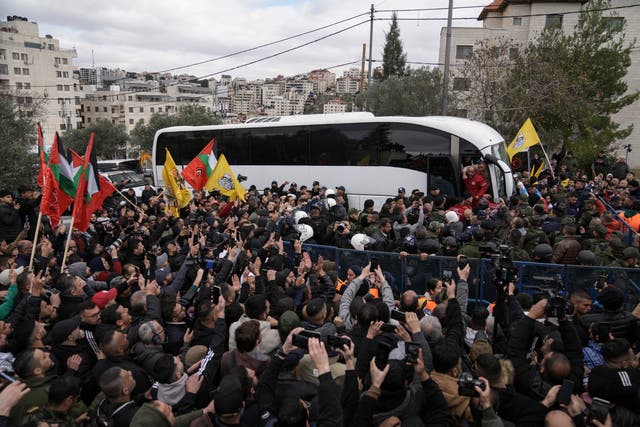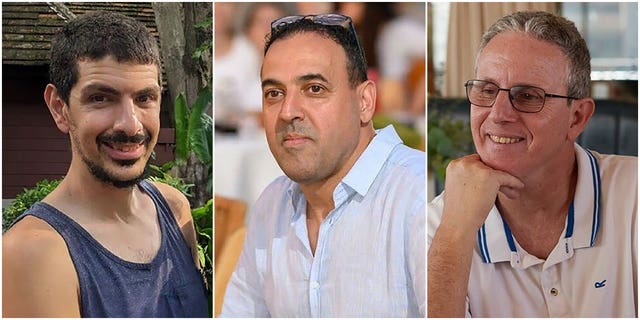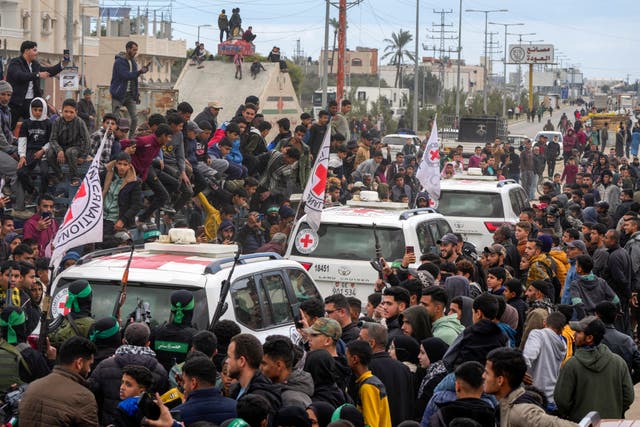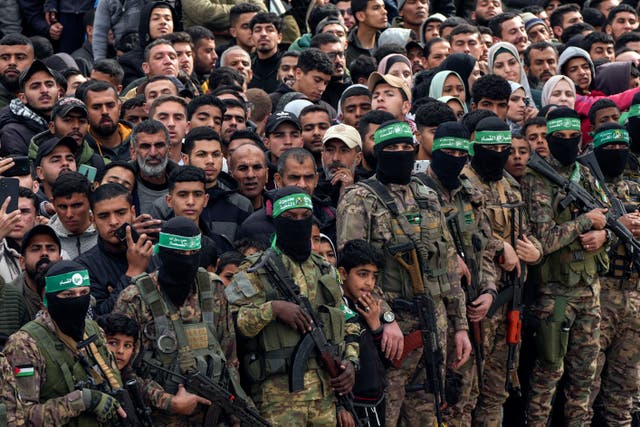Hamas releases three more Israeli hostages for dozens of Palestinian prisoners
The three were among about 250 people abducted during the Hamas-led attack on Israel on October 7.

Hamas-led militants released three gaunt, frail-looking Israeli civilian men they held for the past 16 months on Saturday, and Israel was freeing dozens of Palestinian prisoners as part of an agreement that has paused the war in the Gaza Strip.
Before a crowd of hundreds, armed Hamas fighters led Eli Sharabi, 52, Ohad Ben Ami, 56, and Or Levy, 34, onto a stage, where they were forced to make a public statement before being handed over to the Red Cross.
The three were among about 250 people abducted during the Hamas-led attack on Israel on October 7, 2023, that sparked the war.
They appeared to be in much poorer physical condition than any of the 18 other hostages released so far during the ceasefire that began January 19.
The hostages’ emaciated condition and the stage-managed ceremony — a departure from previous hostage releases where the captives were not made to speak — sparked outrage in Israel.
Prime Minister Benjamin Netanyahu’s office said “we will not accept the shocking scenes” that played out. The statement did not lay out punitive measures.
Israeli opposition leader Yair Lapid said the “difficult scenes” were reason to extend the truce with Hamas and bring home the dozens of remaining hostages.
In an apparent response to concerns over the released hostages’ health, Hamas’ military wing, the Qassam Brigades, claimed it had “made efforts to preserve their lives despite the (Israeli) bombardment”.

Many Palestinians released from Israeli jails during the ceasefire have also appeared gaunt and pale, and have alleged abuses and mistreatment in Israeli custody.
The current phase of the truce, which runs until early March, does not appear to have been affected by US President Donald Trump’s stunning proposal to transfer the Palestinian population out of Gaza, welcomed by Israel but vehemently rejected by the Palestinians and most of the international community.
But it could complicate talks over the second and more difficult phase, when Hamas is to release dozens more hostages in return for a lasting ceasefire.
Hamas may be reluctant to free more captives — and lose its main bargaining chip — if it believes the US and Israel are serious about depopulating the territory, which rights groups say would violate international law.
This was the fifth swap of hostages for prisoners during the ceasefire. Before Saturday, 18 hostages and more than 550 Palestinian prisoners had been freed.

The gaunt appearance of the three hostages “evoke the horrifying pictures from the liberation of the camps in 1945, the darkest chapter of our history”, said the Hostages Families Forum, a group representing relatives of most of the captives.
“We have to get all of the hostages out of hell. There can be no more delays.”
The first phase of the ceasefire calls for the release of 33 hostages and nearly 2,000 prisoners, the return of Palestinians to northern Gaza and an increase in humanitarian aid to the devastated territory.
Last week, wounded Palestinians were allowed to leave Gaza for Egypt for the first time since May.
The 183 Palestinian prisoners being released by Israel on Saturday include 18 people serving life sentences for deadly attacks on Israelis, 54 serving long-term sentences and 111 Palestinians from Gaza who were detained after the October 7 attack but not tried for any crime.
All are men are aged between 20 and 61.
Virtually every Palestinian has a friend, relative or acquaintance who has been imprisoned.
More than 100 hostages were released during a wee-klong ceasefire in November 2023. More than 70 are still in Gaza, and Israel has said 34 of those are believed to be dead. Israel says Hamas has confirmed eight of the 33 to be released during the first phase of the truce are dead.
It is not clear whether Israel and Hamas have begun negotiating a second phase of the ceasefire, which calls for releasing the remaining hostages and extending the truce indefinitely. The war could resume in early March if no agreement is reached.
Israel says it is still committed to destroying Hamas, even after the militant group reasserted its rule over Gaza within hours of the ceasefire.

A key far-right partner in Mr Netanyahu’s coalition is calling for the war to resume after the ceasefire’s first phase.
Hamas says it will not release remaining hostages without an end to the war and a full Israeli withdrawal from Gaza.
In the October 7 attack, some 1,200 people, mostly civilians, were killed.
More than 47,000 Palestinians have been killed in Israel’s retaliatory air and ground war, over half of them women and children, according to Gaza’s Health Ministry, which does not say how many of the dead were militants.
The Israeli military says it killed over 17,000 fighters, without providing evidence. It blames civilian deaths on Hamas because its fighters operate in residential neighbourhoods.
Of the 72 prisoners being released Saturday, five are from east Jerusalem, 14 from the Gaza Strip and the remaining 53 from the occupied West Bank. Seven are to be transferred to Egypt ahead of further deportation.
A total of 47 prisoners were being freed Saturday from Ofer prison in the West Bank, and transferred to Palestinian custody near Ramallah where scores of relatives, friends and supporters welcomed some of them cheering and clapping.
One extremely frail-looking prisoner was loaded directly from a bus into an ambulance for emergency treatment.

The Palestinian security prisoners were detained over offences ranging from bomb attacks to involvement in militant organisations, in some cases dating back decades.
They include Iyad Abu Shakhdam, 49, who has been locked up for nearly 21 years over his involvement in Hamas attacks in crowded civilian areas that killed dozens of Israelis during the Palestinian uprising of the early 2000s. That included a notorious 2004 suicide bus bombing in Israel’s southern desert city of Beersheba that killed 16 people, including a four-year-old.
Another is Jamal al-Tawil, a prominent Hamas politician in the occupied West Bank and former mayor of the village of al-Bireh, abutting Ramallah.
He has spent nearly two decades in and out of Israeli jail, with the military reporting his last arrest in 2021 over his alleged participation in violent riots and efforts to entrench Hamas’ leadership in the West Bank.
He was transferred to administrative detention, a repeatedly renewable six-month period in which suspects are held without charge or trial.
Israel captured the West Bank, Gaza and east Jerusalem in the 1967 Mideast war. The Palestinians want all three territories for their future state.





